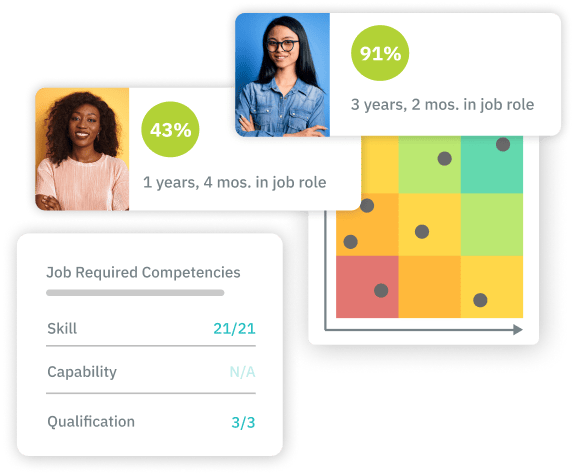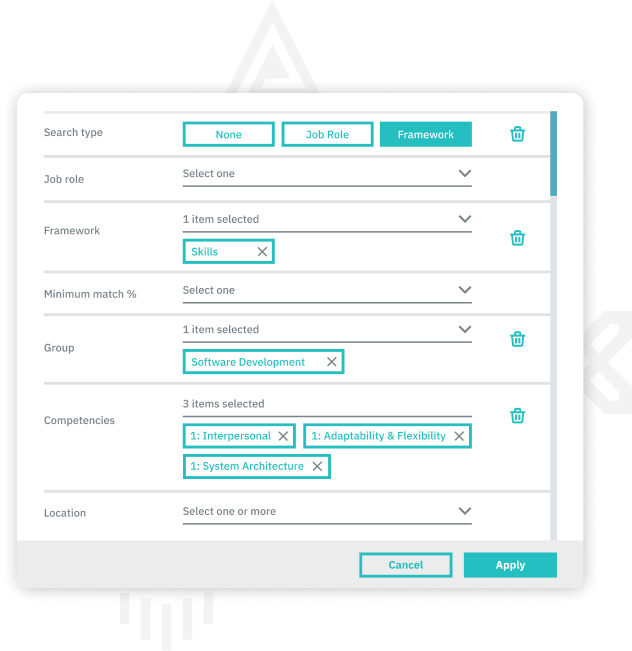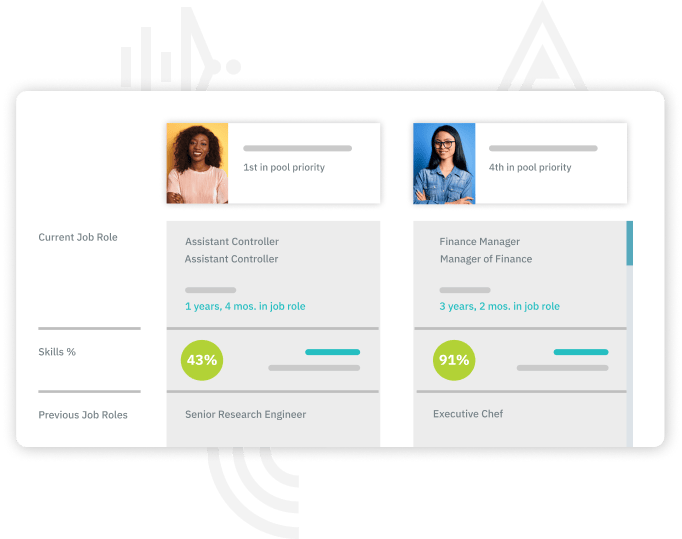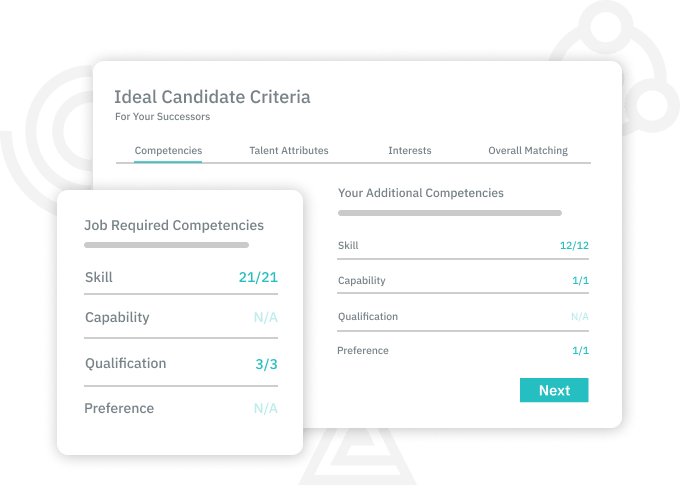Succession Planning Tools
Succession Managementma Tools
Our platform provides the succession management tools you need to plan for the company’s future talent needs and choose the best candidates for the most important roles, based on a complete view of your workforce.


Talent pool builder
Proactively manage succession risks and role vacancies with internal talent pools. Evaluate how well candidates match the role profile and alert management to flight risks.

Targeted internal talent search
Recruit internally based on multiple criteria, including verified skills, competencies, performance, career aspirations, manager recommendations, and more.

Objective candidate evaluation
Reduce bias in your internal mobility decisions with objective, verified skill data. Compare candidates side-by-side based on match percentage, time-to-readiness, previous roles, preferences, and more.

A clear view of future needs
Enable managers to see their teams’ bench strengths, tenure risks, and gaps in role succession so they can develop their people with an eye to the future.

Ideal candidate finder
Wish you could find someone just like your top performer? Use this flexible tool to define the skills, experiences, and other characteristics of your ideal candidate and find internal talent that matches.
See How Our Platform Helps You Build a Future-Ready Workforce
TalentGuard works best with organizations of 500+ employees in the U.S., Europe, Latin America, and regions within six hours of Central U.S.
Every company is at a different stage. Some need to clean up messy job titles and skills first. Others are focused on readiness, mobility, or succession.
Our bundles are built to match those realities. Pick the bundle that’s closest to where you are today, and we’ll tailor the demo to your needs. If you’re unsure whether we serve your region or use case, email info@talentguard.com and we’ll help you find the best fit.
Automate
Competency management for HR with AI automation. Create AI-powered skills, jobs, and career paths, building a strong talent management foundation.
Automate includes:
- WorkforceGPT Copilot powered by Generative AI
- Talent Frameworks: Access to industry-specific pre-built competency models
- Content Management System: Ability to create, edit, manage and map skills, jobs, learning and career progressions.
- Workflow and Approvals Automation
Engage
Enhance employee engagement and retention with impactful strategies that ensure optimal return on investment.
Everything in Automate plus:
- Talent Assessment: Assess employee skills and competencies
- Development Plan: Develop personalized learning paths
- Career Path: Advance employees with recommend career paths
- Analytics: Workforce intelligence insights and reporting
Optimize
Build a robust enterprise foundation to manage and optimize your mission-critical talent management program at scale.
Everything in Engage plus:
- Succession Planning: Build high-potential talent pools
- Performance Management: Review, set goals, & provide feedback
- Certification Tracking: Track employee certifications
- 360 Feedback: Conduct multi-rater leadership feedback
Trusted by Leading Companies Worldwide




Your Workforce is Evolving — Be Ready for What’s Next
Read our eBook
Additional information
Succession management tools enable you to identify candidates whom you might want to place into critical roles when members of your leadership retire or leave your organization. While there are many succession planning tools and templates that are available for download at a cost, you can also find an assortment of free succession planning tools online. Why would you go through the effort of using a succession planning tool, you ask? Great question! There are several benefits to being proactive when it comes to strategizing for the health of your organization.
Succession management tools are essential for organizations aiming to create a resilient workforce by preparing future leaders and minimizing disruptions during transitions. These tools help HR and leadership teams identify high-potential employees, assess skills gaps, and develop targeted career paths for essential roles. Through data-driven insights, succession planning software enables organizations to forecast talent needs, design personalized development plans, and manage talent pools for various levels. With automated tracking, customizable templates, and real-time reporting, these tools streamline the process of ensuring strong, capable successors, ultimately fostering stability and growth.
Succession management:
- Helps disaster-proof your business so you’re prepared with go-to people to put into place, should sudden changes arise
- Identifies your most-qualified future leaders
- Creates a structure for training and development
- Ensures you have extra eyes on particular roles and responsibilities
- Maintains brand identity
- Keeps your company planning for long-term goals
Plus, once you make succession management a regular part of your organization’s routine, it’ll be second nature to keep an eye on upcoming talent and track their progress as they grow through your company.
Succession Planning Toolkit
As you embark on your journey to plan for your organization, you might consider starting with a succession management toolkit. A toolkit PDF is a great way to force your leaders to think about your brand in ways they might not consider on a day-to-day basis. Toolkits usually include the following materials:
- Succession management questionnaire – This tool will help you identify significant business challenges in the next one to five years
- Succession management report example – This will give you an idea of what your results will look like after you’ve examined the current and future states of your business
- Succession management worksheet – This is what you’ll use to get into the analysis of your organization, identifying what’s going on currently, what kind of changes are expected to take place in the near future, what critical roles you have in your business, and the critical success factors that would make someone who needs to step into leadership positions be successful.
Leadership Transition Framework
A leadership transition framework can be beneficial for getting started with succession management while supporting a salable and replicable approach. When you utilize a template for managers, you’ll be able to see different perspectives of your business, which can help you identify any gaps in your brand’s mission and values. Succession templates come in a variety of formats and can be used to support success at various levels of an organization. The following are some types of succession templates you might consider using:
- Leadership Transition Framework Excel. Free versions of this type of template can be found online. This is often a great option because many leaders and HR professionals are accustom to using Excel in their daily routines.
- Leadership Transition Framework Word format. There are great Word versions of succession planning documents, too. These are great options if you want to brainstorm thoughts and record observations about your company. Of course, you can always combine Excel and Word templates to gain the most perspective possible.
- A Framework for government agencies. Government agencies operate much differently than corporate or small business environments. If you’re in the governmental sector, seek out a succession planning template that’s designed with your organization’s unique needs in mind.
- Talent and succession planning boilerplates. What makes good employees great at what they do? How can you replicate their passions, skills, and abilities in future candidates? A talent and succession planning template will help you better understand where successes and opportunities lie within your current staff and future candidates.
- Leadership template. The last thing you want to happen is to have a vacant CEO position with no viable prospects to step in and take charge. This is why leadership succession plans are imperative for your C-suite executives.
- Emergency succession plans. Unfortunately, you can’t always plan for everything, and sometimes, life makes you scramble to find solutions. An emergency succession plan template will help guide you through the process so you enjoy as optimal an outcome as possible.
If you’re looking for a some templates, SHRM has a customizable presentation that can help you better understand why these steps are important and present your thoughts to applicable team members. This will help everyone get on the same page with succession management template and process activities. Once everyone’s viewed the presentation, you can distribute a succession planning template PDF that relevant leaders can fill out and submit back to you.
Succession Example
If you’re looking for a succession plan example, consider this one from the University of Washington. Note how this succession plan example PDF guides you through ways to assess, evaluate, and develop your organization. It’s a simple succession plan example, but it does the job, making you think about your company from a critical point of view. In this company succession plan example, you’ll see how it begins with step one forcing you to think about the current and future states of affairs for your organization. Following that, step two asks you to identify critical positions that will be needed to support business continuity. The following steps then focus on what you can do to achieve optimal success and minimal disruptions within your work environment. This company succession plan example is a great starting point if you haven’t examined the health of your company for a while.
Succession Management Model
A succession management model represents an integral part of succession planning. As part of your succession framework, you might consider working from a number of different models, such as the 9-box model. This model example shows an individual employee’s current and potential level of contribution to the organization. A model of a company helps leaders understand where their most valuable assets are so they can work to bolster their career paths moving forward. As you begin assessing your organization, consider using the succession model PDF templates. There are many different succession model templates that you can find online, so you don’t have to try to start from scratch when you’re just getting started in the process.
Succession Management Process
Now that you know was the various different applications of succession management are, we can dive into the succession process. SHRM explains the process well. In short, your succession strategy enables you to develop leadership talent that’s brought up within your organization’s culture values and norms, ensuring consistency of the brand and continuity of work when leadership members need to be replaced. Take a look at this succession planning PPT to get a slide-by-slide view of the process and see a sample strategy put into place. Indeed also offers a template that explains various types and walks you through how to get the most out of the various models.
Succession Management Software
The aforementioned strategies can be streamlined and better supported with succession management software. The best succession software options will offer heaps of features that enable you to capture employees’ skills and proactively identify potential candidates for roles, either as internal or external applicants. There are dozens of succession systems available; Some succession solutions are a bit costly, but there are affordable and even free versions, too. Succession management software free versions won’t have as many bells and whistles as paid versions, of course, but they can still help you see your organization in a critical way. If you’re looking for a succession management tools, it might be easier to start with a free version so you can see what kind of functionality would work best for your organization, should you choose to upgrade to a paid option.
Plan Proactively with Intelligent Succession Tools
With the best succession planning software and today’s leading platforms, companies can spot looming talent shortages long before critical roles become vacant. These systems apply sophisticated predictive analytics to create detailed staffing models. Leaders can then optimize resource allocation and cultivate employees for future leadership roles. With proactive succession management tools, you’ll spend less time scrambling to fill gaps and more time cultivating a resilient leadership bench.
Integrating succession management software into your HR tech stack means you can automate alerts for upcoming retirements, track readiness scores, and distribute personalized development plans. These capabilities transform your approach from reactive firefighting to strategic talent cultivation. For a deeper dive into building cohesive teams that align with these proactive efforts, check out our guide on Building the Best Team.
Identify and Prepare High-Potential Successors
Use practical succession planning tools to identify employees whose skills and aspirations match your organization’s long-term objectives. These solutions review each person’s competencies, career goals, and performance history to surface talent that might otherwise slip through the cracks. Succession planning software ensures you’re not relying on gut feeling alone; instead, you’re making data-driven decisions that reduce bias and maximize internal mobility.
Once you’ve identified top talent, succession management software facilitates tailored development plans with skills assessments, mentorship opportunities, and stretch assignments. These tools reveal each candidate’s growth trajectory, enabling HR leaders and managers to assess readiness and offer timely support. As a result, potential successors are well-equipped when advancement opportunities arise.
Visualize your Talent Pipeline with Dynamic Talent Pools
Dynamic talent pools give you an up-to-the-minute view of your bench strength and highlight emerging leadership gaps. Intuitive dashboards enable you to sift through talent pools by skill match, development milestones, and retention risk. This focused view directs your succession efforts to the areas that matter most, preserving leadership continuity organization-wide.
Top succession planning software allows you to compare candidate cohorts side by side, making it easy to spot readiness timelines and competency gaps at a glance. Maintaining these internal talent pools turns succession planning into a continuous process that adapts to workforce shifts and evolving business strategies.
Bridge Skill and Performance Gaps with Data Insights
Your succession planning tools use built-in analytics to highlight skill and performance gaps. Matching competency frameworks with individual profiles uncovers precise training needs and potential blockers. With these insights, you can focus your learning and development investments on the most critical areas.
Linking your succession planning template to real-time performance metrics creates a seamless feedback loop. The platform updates readiness scores and flags emerging gaps as employees complete targeted development activities. This continuous assessment, development, and evaluation cycle means your succession strategy remains agile, and your organization stays ahead of talent challenges.

